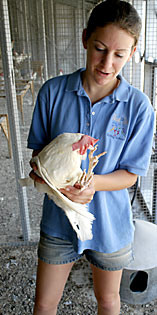 |
|
JOSHUA SILLS/Arizona Daily Wildcat
|
Emma Timmernan, a veterinary psychology senior holds one of the Veterinary Diagnostics Lab's chickens. The chickens are used to monitor the West Nile Virus among others.
|
|
|
By Dana Crudo
Arizona Daily Wildcat
Tuesday August 26, 2003
Recent finding in Arizona concerns UA scientists
Now that the West Nile Virus has hit Arizona, UA scientists are urging students to take their own preventive measures to avoid the mosquito's fateful bite.
On Aug. 11, Arizona recorded its first case of the West Nile Virus, after a mosquito tested positive in San Simon, located near the Arizona-New Mexico border. Three days later, the virus was found in horses on the Navajo reservation, which stretches along northeastern Arizona.
Although no human cases have yet to show up in Arizona, now is the time to begin taking safety precautions in order to avoid the high numbers of cases plaguing other states, said Frank Ramberg, UA entomologist researcher, who has been collecting mosquitoes to research the virus.
"Since pools of water serve as breeding grounds for mosquitoes, students need to remove pools of water around their own dorms and apartments, and become more aware," said Henry Hagedorn, a UA entomology professor who researches and writes articles about the virus. "If they see pools of water on campus they need to tell somebody."
Examples of breeding sites are fountains, in which the water should be changed every five days, or objects that collect water after it rains. Washes are also a danger zone if the water is not drained after it rains.
"A not so obvious site is dumpsters that are full of dry objects, like newspapers, underneath those newspapers could be water serving as a breeding place for mosquitoes," Ramberg said.
In addition, students need to inform facility managers if they see adult mosquitoes in a building, Ramberg said.
Students should make sure they have screening on their windows as well, he added. Moreover, if they have lily ponds or other types of standing water they cannot remove, substances can be bought that kills the mosquito larva.
The majority of people that contract the virus will not even know they are sick, Hagedorn said. If there are any symptoms at all, they usually consist of fever, body aches, swollen lymph nodes, and a body rash, with very few cases resulting in tremors, disorientation, and convulsions. The disease can be fatal.
Students should try to stay indoors when mosquitoes are out or wear thicker clothes, like long pants and sleeves, to prevent mosquitoes from biting. Insect repellants can also serve as protection, but Ramberg cautions not to apply the repellant directly to the skin.
"Students should also be aware of song birds suddenly dying off or acting in any unusual behavior, those could be signs that the West Nile Virus has infected them," said Peder Cuneo, a specialist at the UA Veterinary Diagnostic Lab.
The lab routinely tests chickens and birds for traces of the virus. Birds are the host of the virus, which is then transferred to humans by mosquitoes that have bitten them, Cuneo said.
Such tests are important because once the virus is detected in birds it usually takes 6 to 8 weeks before a human is infected, Cuneo said. So far no birds in the Tucson area have tested positive for the virus.
Regardless, the virus will definitely infect humans soon; it's just a matter of time, Ramberg said.
This year, 450 human cases have been reported nationally, resulting in 10 deaths. Colorado, the state hardest-hit so far, has had 6 deaths and 250 cases.
"Everybody should be getting involved in making sure the campus is safe and protected from the West Nile Virus," he added.
